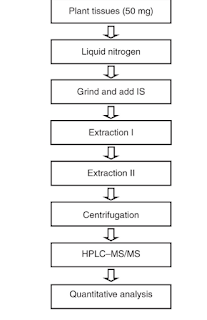Plant Hormone extraction,
analysis, and quantitation
* Hormone extraction and identification has been made possible due to advances in
chemical analysis, chromatographic techniques, and mass spectrometry.
* It is difficult to extract and identify plant hormone from plant extract as the extract contains major metabolites, such as sucrose, also hormones concentrations in plant tissues are low up to more than ten times compared to other material in plant tissue.
* Another thing that effects identification and extraction is the complexity in structure of plant hormones.
* Chemical properties of phytohormone also effect hormone analysis, quantification and extraction.
* Wide range of chemical properties, many hormones (e.g., gibberellic acid
and brassinosteroids) are quite hydrophobic, while hormones like auxins and
cytokinins are more hydrophilic.
* Keeping the diversity of solubility, Structure and chemical
nature in view, tissue homogenates are subjected to “clean up” or enrichment
methods by partitioning between aqueous and organic solvents prior to separation
by liquid chromatography (LC) and gas chromatography (GC).
Analysis and Extraction Of Phytohormones
Extraction procedure for plant hormones
1.Mass spectrometry
(MS): Mass Spectroscopy offers fast and sensitive analysis of plant hormones. Mass spectrometry can identify what compounds they are through identifying their accurate molecular weights.
MS Spectra of plant hormones
2.Liquid Chromatography-Electron Ionization- Spectroscopy(LC-ESI-MS) :This method combines the resolution of high-performance liquid chromatography (HPLC) separation with the high mass accuracy of the mass spectrometer.
3.“Triple quadrupole” instrument allows analysis of multiple target ions, whereas chosen ions can be
captured and fragmented for structural analysis using “ion trap” instruments.
4.Direct coupling of various techniques with LC or GC instruments offers
efficient separation, identification, and quantification of hormones.
5.Latest technological advancements now permit simultaneous analysis of several hormones in a
single extract of biological sample.
6.Characterization of plant hormone action in cells
and tissues is greatly facilitated by the use of reporter genes like β-glucuronidase
(GUS) and green fluorescent protein (GFP) linked to a promoter sequence from a
gene for plant hormone response or biosynthesis. GUS assays have the disadvantage
that they are destructive in nature. Moreover, the diffusive nature of blue product of
GUS reaction reduces resolution. In contrast, fluorescent proteins, such as GFP, have
high resolution and sensitivity, and are nondestructive in nature, thus allowing live
cell imaging.
7.New biosensor methods are
now coming up to detect hormones and their biomolecular interactions.
8.These
include fluorescence resonance energy transfer (FRET), surface plasmon resonance
(SPR), and luminescence techniques.
9.Chromatography: Chromatographic techniques such as gas and liquid chromatography are available to separate compounds with different polarity, molecular weight and/or electronic charge.
10. In 1969, gas chromatography-mass spectrometry (GC-MS) was first applied to measure the concentration of GA (Binks et al., 1969). With the development of this technique, tandem mass spectrometry (MS/MS) was invented, which provides more sensitivity and accuracy than the original mass spectrometry.
11.Solvent Extraction method.
12.HPLC
13.Immunoassay measures phytohormone concentrations using the affinity between labeled antigens (phytohormones) and specific antibodies, but can only be applied to quantify the phytohormones with high concentrations since its sensitivity and specificity are low.
14.Plant hormones are determined using reverse-phase liquid chromatography–tandem mass spectrometry with multiple reaction monitoring. The method provides quantification of most major plant hormones in a single run from 50 mg of fresh plant tissue.





Comments
Post a Comment